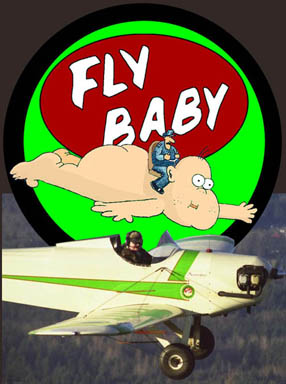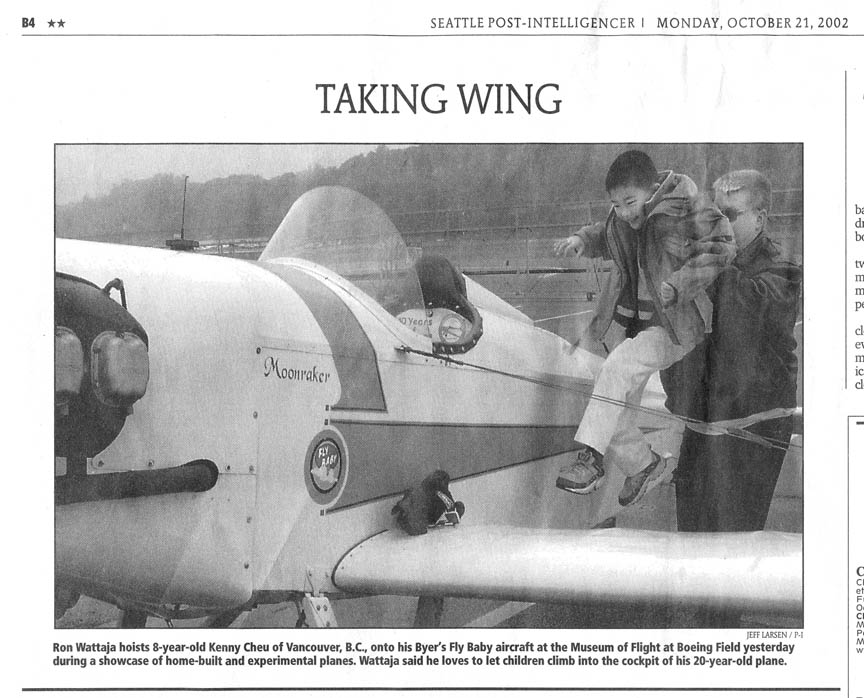Giving Rides in Your Fly Baby
February 2009

Don't worry... I'm not talking about taking people aloft in your Fly
Baby. Though strangely enough, there *is* a history of passengers
being carried in
single-seat airplanes. In WWII, there are cases where two people
would
cram themselves into a single-seat fighter, generally in situations
where someone was in danger of being captured by the enemy. You
can see cinematic depictions of these in 1969's "Battle of Britain" and
1948's "Fighter Squadron".
But in this case, I'm
talking about giving people...especially kids...the opportunity to sit
in your plane.
It's something I do all the time at Fly-Ins and other activities where
the non-flying public comes to the airport. Why?
- It's good PR for General Aviation. If people have pleasant
memories of activities at the local airport, they'll be less likely to
support efforts to close it. Few parents go anywhere without a
camera these days, and most of them leap at the chance to shoot some
pictures of their kid in an airplane.
- It thrills kids who are interested in planes and might become
pilots some day, and for those who hadn't been interested in airplanes
and flying, it might get them thinking about it. In the process,
I end up answering a lot of questions about what it takes to learn to
fly, how much the airplanes cost, etc. It's amazing how many
people are astounded to be told that I bought my plane for less than a
new car would have cost.
- It's fun for me, too!
I've been doing this since I started flying Fly Babies (over twenty
years) and have run dozens of folks though the cockpits and never had
any sort of airplane damage occur. Here's some guidelines:
 Picking the
Passenger
Picking the
Passenger
One thing I *don't* to is stand like a huckster offering tours, or let
anyone advertise that I'm going to let folks into the cockpit.
It's not my goal to set up an "assembly line" and route people in and
out continually. I just keep my ears open when folks come by the
airplane. You soon hear a kid asking a lot of questions that Mom
and Dad can't answer, or someone will start asking you questions about
what it's like to fly, how much it costs to own, etc. If there's
a huge crowd about, I usually don't offer cockpit tours, as then you
*do* end up with a bunch of people lining up to come on board...and you
don't really want that.
The nose art for my plane attracts a lot of toddlers...the parents like
to show them the "Flying Baby" forward of the cockpit.
Anyway, after a few minutes' talking and answering questions, I ask the
person if they'd like to get into the cockpit. Keep in mind
that some people may not have the flexibility nor the strength needed
to get into and out of the plane; obviously, if it's an elderly man
with a cane, you'd best not suggest it.
Usually the adults and kids light up at this point. Sometimes,
you'll find a kid (usually a younger child) that is a bit scared.
Don't push them! Scared kids are more likely to panic and maybe
try run across the wing. Take their side... "Oh, it's all
right, he doesn't have to if he doesn't want to." Often when
their brothers or sisters (or their parents) take a turn in the
cockpit, they turn around. But you want their memories to be fun,
so don't let them be forced.
Safety Briefing
Before you let someone into the cockpit, give them a little safety
briefing. This tends to calm down the over-excited kids, and
gives adults the message that we pilots are people who take safety
seriously.
Typically, at a Fly-In, you're parked nose-in. Keep folks away
from the propeller, of course...in fact, it's best to lead them around
the wing to make sure they don't knock off the pitot boom on the
leading edge of the left wing.
I lead them around to the cockpit entry on the left side. The
first thing you want to be concerned about is preventing a kid from
trying to run or walk atop the fabric on the wing. I gently touch
the fabric outboard of the wing-walk and explain that it's just
cloth. "If you walk out here, you'll crash through it all the way
to the ground. I'll be very unhappy, and you'll look very, very
stupid." Most people aren't as worried about hurting your plane
as they are about looking stupid, so this approach works real well.
I knock on the wingwalk to show them it's solid. You should
have a no-skid strip. I don't tell folks that it's wood forward
and aft of the strip, as it's a lot easier for folks to stay on the
colored area than to remember to stay within ~10" of the fuselage.
Caution them NOT to use the windshield as a grab bar!
Obviously, you want to tell them about any switches or controls that
they shouldn't touch. Most folks are skittish enough that they
won't fiddle with anything unless you specifically give them
permission. One thing neat about a Fly Baby is there's generally
less fragile stuff in the cockpit.
Cockpit Preparation
Glance in the cockpit and make sure it's ready for visitors. Tuck the
seat belt beside the seat, and move the shoulder harness straps out of
the way. Take anything off the seat (of course), and make sure
all the switches are off. If you've got "accessories" (more
later) in the baggage compartment, take them out now.
Boarding Instructions
Little kids will usually need to be lifted onto the wing walk.
You can do that yourself, but usually the fathers will do that.
If it's a kid, the main thing is to position him or her so they can
grab onto the cockpit coaming for support.
Bigger kids, teens, and adults can make the step themselves, though
that first step onto the wing walk from the ground is a doozy.
Have them hold the coaming for support during the big step.
Once they're on top of the wing looking into the cockpit, re-assure
them that they can step on the seat. Most folks are reluctant
to. Have them step over the cockpit sidewall, holding the
headrest (NOT the windshield) for support.
If it's a toddler at this point, having them sit down it
pointless...they'll usually just disappear. Otherwise, point out
to them the area where their legs go (a surprising number of people try
to sit with their feet on either side of the stick) and let them slide
into place.
Photos
Of course, people want their pictures taken in the airplane. I
feel the best position for this is right in front of the left wing next
to the fuselage. It shows the cockpit, without having the
person have to turn awkwardly around to look behind the airplane.
Often, people go out by the wingtip to shoot the entire plane with
their kid or friend in it. That's fine, too, but encourage them
to get a closeup by the cockpit, too. Be prepared to take photos
with other people's cameras.
But first comes "Accessorizing". I carry a spare flying helmet in
the airplane, and usually slip it on kids when they get aboard.
Parents love the photo opportunity. You can buy cheap helmets for
$20 or so, and some places even carry kid's helmets. These aren't
really intended for flight, but work find for pictures. I don't
let visitors use my "gamer" (the helmet I fly with) as it has a headset
built in and it's tougher for newcomers to put on.
I often carry a spare silk scarf, too. As the parents take
pictures, stand aside and hold the scarf straight back like it's
streaming in the wind (see the picture on the right at the start of
this article).
The Tour
The in-the-cockpit tour should be pretty obvious. Point out the
gauges, explain what they do. Have the person take hold of the
stick (somehow, kids see to grab it immediately anyway) and move it
from side to side. Point out how the ailerons move...remember,
the have them look in the direction the moved the stick, as the
up-going aileron moves the most. Adults and bigger kids can move
the stick back and forth and see the elevator move, too.
Having Fun
There's two main things I do to have a little fun with kids.
First, before letting them in the cockpit, I ask:
"You always get aboard an open-cockpit airplane from the left
side. Do you know why that is?"
The answer is, "Because you mount a HORSE on the left side!" The
early military aviators often came from the cavalry. The early
Army Air Service actually required that pilots wear spurs while
flying. Most of the purchasers of early airplanes were rich men
who probably rode horses fairly often, too.
Point out how long this tradition has continued...remind them of their
last trip on an airliner: The jetways almost always connects to
the left side of the plane!
If you've got a really, really good day going, some smart-xxx kid will
ask, "Well, why do you get on a HORSE from the left side?"
The answer for that is simple, too: It's so your sword doesn't
tangle! Remember, you wear your sword on left side (if you're
right-handed). If you mount a horse from the right side, you'd
have to manually lift the sword scabbard over the back of the horse as
you swing your left leg over the back.
The second thing is an evil, evil trick. I don't like to do it to
the younger kids, since they'll get scared. Teenage boys and
adults can get a little upset at having such a trick on them. But
gawd help me, it's funner than heck with teenage girls.
Have them get in the cockpit. Show them how the stick moves left and
right to move the ailerons. Then move behind the airplane and
grasp the tailwheel spring. Call out "Ok, pull the stick
back towards you." When the elevators go up....
....Pick the tail off the ground and raise it high. I often shake
it a bit, for good measure.
Yes, I know the motion is in the wrong direction for the stick
movement. But the screeches from the cockpit are worth it. :-)
Climbing Out
As you know, getting OUT of a Fly Baby is usually a bit tougher than
getting in. One problem here is that folks want to put their legs
down to push, and will end up trying to stand on the aileron linkages
unless you keep your eyes open. Point out where they can brace
themselves.
As they stand and climb onto the wingwalk, remind them not to use the
windshield for a support...but the cockpit coaming and headrest are
fine.
When kids are standing atop the wingwalk ready to get to the ground, I
usually suggest they jump. Kids actually like that, but offer to
lift the smaller ones off the wing. Adults can usually get down
on their own, but offer them a hand for support
Wrapping Up
Back during the year I was a co-owner of a Stinson 108, I flew 37 Young
Eagles. It's one thing I miss, having a single-seat
airplane.
But the cockpit rides are a good substitute, and it's good public
relations for General Aviation. In all the years I've done it, I
haven't had a single problem with damage, even when it's a batch of
rambunctious teenagers. Again, you don't let "just anybody"
aboard, but if you can tell that they're interested in airplanes, it's
a real good chance that they aren't looking forward to damaging one!
Ron Wanttaja
 Return to the
Stories Page
Return to the
Stories Page


 Picking the
Passenger
Picking the
Passenger
 Return to the
Stories Page
Return to the
Stories Page